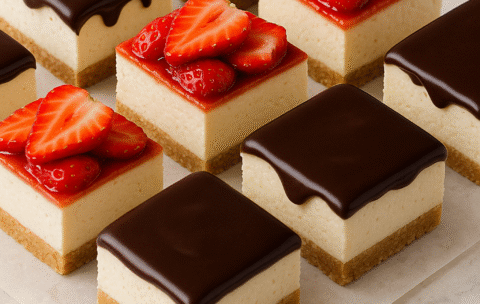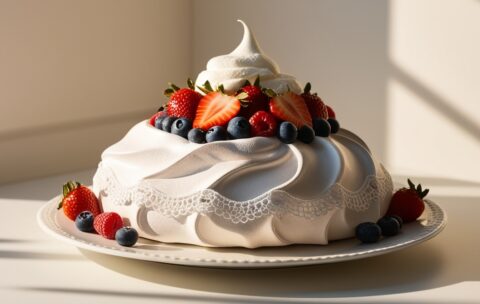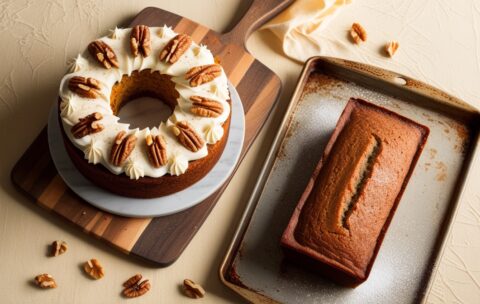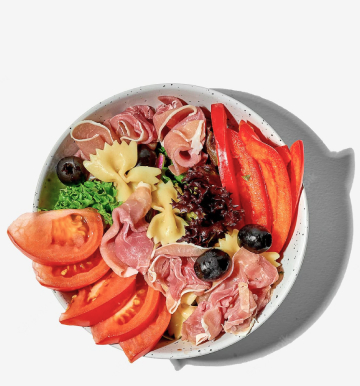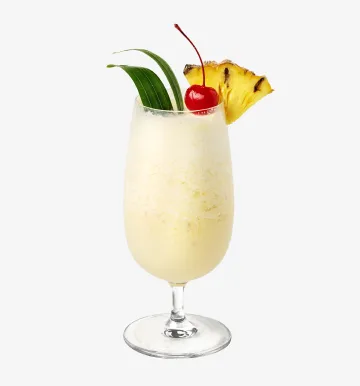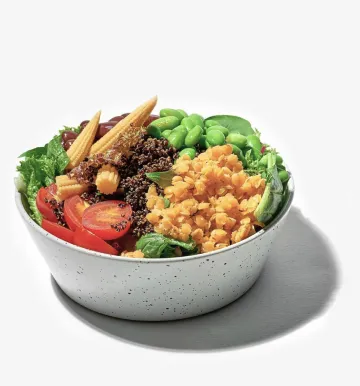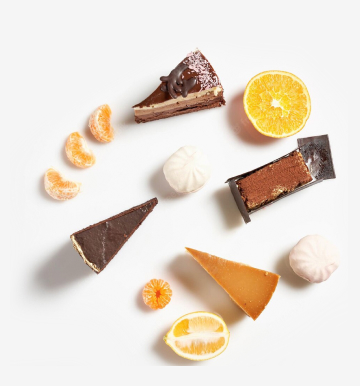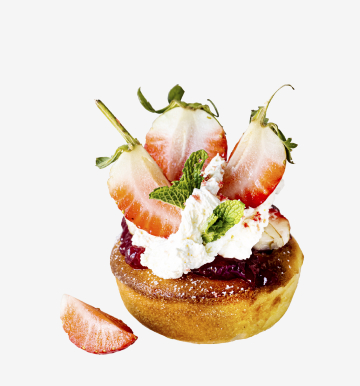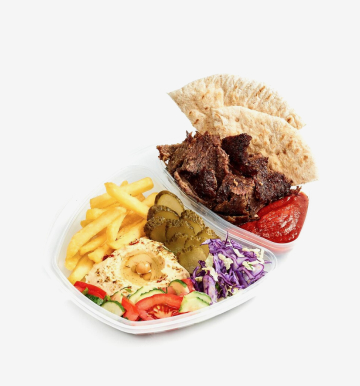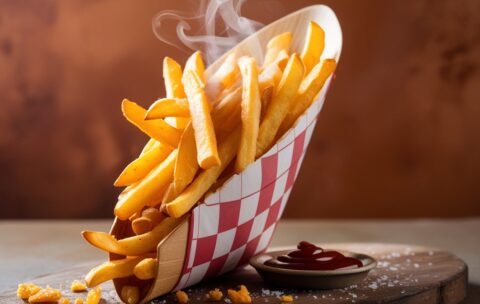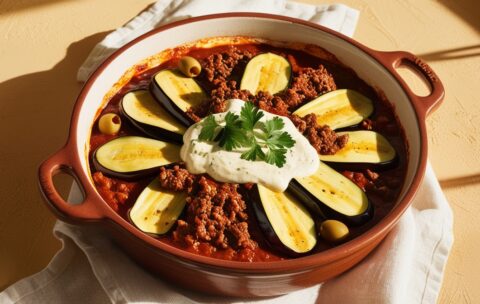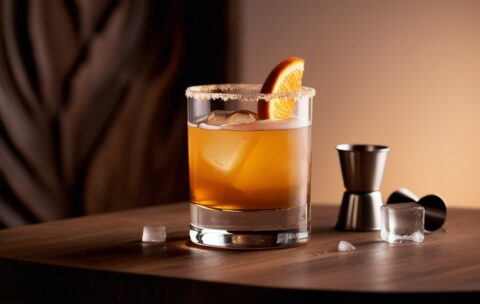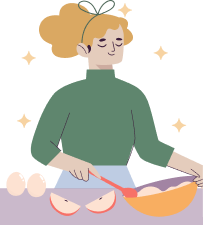Home Update 02
October 4, 2023 2025-06-05 13:04Home Update 02
Become a Home Chef
Learn to cook from scratch and master restaurant-quality meals in your own kitchen. Perfect for beginners and food lovers.

Our Top Courses
We've selected the best programs to get you started. Each course offers step-by-step lessons, hands-on recipes, and guaranteed results — even for beginners.
No-Bake Cheesecake Layered Cake Squares
5 Lessons
3.5 hours
Intermediate
What you'll learn
Preparing and pressing the ideal crust (graham, cookie, or nut-based)
Mixing smooth, lump-free cheesecake filling with flavor variations (vanilla, citrus, chocolate)
Layering multiple cheesecake batters for striped or marbled effects
Setting and chilling methods to ensure clean, precise slices
Decorating techniques: fruit compotes, ganache drips, whipped cream piping
Cutting and serving tips to maintain sharp edges and professional presentation
Panna Cotta
5 Lessons
2.4 hours
Intermediate
What you'll learn
The fundamentals of making a perfectly smooth, classic Vanilla Panna Cotta with no grainy texture.
How to bloom and incorporate gelatin for optimal set and mouthfeel.
Techniques for infusing cream with aromatics (e.g., vanilla beans, citrus zest, coffee grounds) without overcooking.
Troubleshooting common issues (e.g., weeping, over‐firm Panna Cotta, air bubbles).
Recipe adaptations for dietary preferences (e.g., coconut-based Panna Cotta for a dairy-free alternative, agar-agar substitutions for vegetarian).
Creative topping and garnish ideas: fruit coulis, macerated berries, caramel shards, chocolate curls, and edible flowers.
Elegant plating and serving methods (serving in molds, serving “naked” in jars, layering with compotes).
Pavlova
4 Lessons
3.3 hours
Intermediate
What you'll learn
Meringue Fundamentals (Paragraph + List):
You’ll understand how to whip egg whites to the correct stiffness and fold in sugar without deflating the mixture.
Recognize stages of beaten egg whites (soft peaks → stiff peaks).
Techniques for incorporating sugar gradually.
Identifying when the meringue mixture is ready for baking.
**Shaping & Baking Techniques (Table):
Step Key Tip
Piping vs. Spreading Use a piping bag for defined edges; spread with a spatula for a rustic look.
Forming a Well Create a shallow indentation in the center to hold cream and fruit.
Oven Temperature Start at 120 °C (250 °F) for 15 min, then reduce to 90 °C (200 °F) to dry.
This table highlights how small adjustments in technique and temperature impact the final texture.
Cream & Fruit Assembly (Paragraph):
Learn to prepare stabilized whipped cream so it holds shape, and choose complementary fruits (e.g., kiwi, berries, passion fruit) to balance sweetness and acidity.
Loaded Nachos
5 Lessons
2.6 hours
Intermediate
What you'll learn
Chip Selection & Prep: How to choose sturdy yet crispy tortilla chips to prevent sogginess under heavy toppings.
Protein Options: Techniques for seasoning and cooking ground beef, shredded chicken, or black beans to use as a hearty nacho base.
Cheese Melting Methods: Tips for pairing cheeses (cheddar, Monterey Jack, Pepper Jack) and getting an even melt under the broiler or in the oven.
Layering Strategies: The optimal sequence for chips, beans, cheeses, proteins, and vegetables so each bite has balanced texture—no more soggy bottoms or cold patches.
Homemade Toppings: Quick recipes for pico de gallo, guacamole, and sour cream drizzle, plus how to pickle jalapeños or shred lettuce for freshness.
Garnishing & Presentation: Final touches—cilantro, green onions, lime wedges, and diced tomatoes—to turn a simple tray into an Instagram-worthy platter.
Serving & Reheating: Best practices for keeping loaded nachos warm, how to reheat leftovers without losing crispiness, and portion guidance for parties of various sizes.
Decorative Piping & Sugar Flowers
3 Lessons
4.3 hours
Intermediate
What you'll learn
Icing Consistency & Color Blending
Adjusting buttercream and royal icing to the proper firmness for different piping tasks.
Techniques for tinting icing and gum paste to achieve natural, gradient effects.
Piping Basics to Advanced Motifs
Foundational strokes (dots, lines, shells) leading to scrolls, rosettes, ruffles, and lace patterns.
Creating texture, dimension, and contrast through varying pressure, speed, and tip selection.
Sugar Flower Construction
Preparing and conditioning gum paste and fondant for pliability.
Forming petals, leaves, and buds for common flowers (roses, peonies, ranunculus).
Assembling individual elements into realistic bouquets and sprays.
Composition & Placement
Designing balanced cake layouts: focal points, color harmony, and scale.
Securing decorations on tiered and multi-surface cakes without collapse.
Troubleshooting & Finishing Touches
Preventing issues such as cracking, sagging, or color bleeding.
Applying final details: dusting, veining, and edible luster for lifelike appearance.
Grilled Salmon with Lemon Butter
4 Lessons
1.8 hour
Intermediate
What you'll learn
Outcome Description
Selecting Quality Salmon Identify sustainable salmon cuts (filets vs. steaks), check for freshness, and understand label terms (wild-caught vs. farmed).
Marinade & Seasoning Techniques Prepare a simple herb-citrus marinade that enhances flavor without overpowering the fish.
Grilling to Perfection Control grill temperature, manage flare-ups, and achieve crisp skin while maintaining a juicy interior.
Preparing Lemon Garlic Butter Combine melted butter, fresh lemon juice, garlic, and herbs to create a bright finishing sauce.
Doneness & Presentation Use visual cues and a thermometer to judge when salmon is cooked through (125–130°F / 52–54°C), and plate with complementary garnishes.
Lobster Roll with Garlic Butter
4 Lessons
3.3 hours
Intermediate
What you'll learn
How to select, buy, and cook fresh lobster meat (from boiling/steaming to picking meat).
Techniques for making flavored garlic butter (infusing with garlic, herbs, lemon zest).
Proper seasoning and temperature control to keep lobster tender and juicy.
Best practices for toasting split-top hot dog buns or brioche rolls so they hold up and absorb butter.
How to assemble and garnish a Lobster Roll (balancing textures with finely chopped celery, chives, or parsley).
Salvatore’s Legacy
5 Lessons
3.3 hours
Intermediate
What you'll learn
How to select and source top-tier amaro and ultra-aged rum for balanced depth
Techniques for saffron-infusing sweet vermouth and achieving optimal flavor extraction
Proper stirring methods to maintain clarity and texture
The importance of glassware choice and garnish to enhance aroma and presentation
How to adjust sweetness and bitterness ratios to suit individual palates
Pairing Salvatore’s Legacy with fine cheeses, dark chocolate, or light desserts
Carrot Cake & Spiced Loaf Cakes
2 Lessons
2.2 hours
Intermediate
What you'll learn
How to grate carrots (or prepare alternative base ingredients) to achieve ideal moisture and texture
Techniques for toasting nuts and folding mix-ins to prevent a heavy crumb
Spice blending ratios for cinnamon, nutmeg, ginger, and cloves to balance warmth and sweetness
Methods to cream butter and sugar just enough—no overmixing—so loaves rise evenly without tunnels
Frosting options: crafting classic cream cheese frosting, drizzling brown butter glaze, and applying a neat powdered sugar dusting
Variations on the base recipe (apple-spice, pumpkin-spice, coconut-carrot) to adapt to seasonal ingredients
Decadent Cheesecakes: From No-Bake to Baked
3 Lessons
1.3 hour
Intermediate
What you'll learn
No-Bake Cheesecake Fundamentals
How to prepare a sturdy, crisp graham cracker (or digestive cookie) crust without baking
Proper gelatin blooming and incorporation techniques for a stable filling
Folding methods to achieve a light, airy texture without deflating whipped cream
Creative topping ideas: fruit compotes, chocolate ganache, caramel drizzle
Baked Cheesecake Mastery
Techniques for preventing cracks: water bath assembly, gentle mixing, and controlled cooling
How to achieve an ultra-creamy, custardy center by managing oven temperature and bake time
Making and baking a fail-proof graham/digestive cookie crust
Flavor variations: lemon zest infusion, pumpkin swirl, poppy seed blends, and espresso accents
Decoration & Presentation
Piping whipped cream rosettes around the rim with a star tip
Arranging fresh fruit in radial patterns and glazing for shine
Adding textured accents: nut crumbles, chocolate shavings, and edible flowers
Troubleshooting & Tips
Solutions for common issues: cracked tops, dense centers, runny fillings, and weeping
Ingredient substitutions (e.g., gluten-free crust options, non-dairy alternatives)
How to scale recipes up or down for 6-inch mini cheesecakes, pie-sized “cheesecake tarts,” or 10-inch party-size
Choose Your Category
Our courses are grouped by category to help you find what suits your taste. From quick dinners to gourmet desserts — start with what inspires you.



About Our Culinary Journey
We are passionate about bringing the joy of cooking to everyone. Our mission is to empower food lovers with the skills and confidence to create delicious meals at home. With expert chefs, innovative teaching methods, and a love for culinary arts, we’re here to inspire your kitchen adventures.
Our Commitment
Everyone can cook well. Our courses offer clear guidance to ensure success for all skill levels.
Community Focus
Join our foodie community. Share creations and grow in a supportive environment.
Why Choose Our Culinary Courses?
Our courses are designed to make cooking fun, accessible, and inspiring. Whether you're a beginner or a seasoned cook, our unique features will help you elevate your skills and unleash your culinary creativity.

Expert Instructors
Learn from world-class chefs with years of experience. Our instructors guide you step-by-step, sharing professional tips.
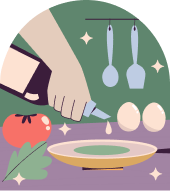
Flexible Learning
Study at your own pace, anytime, anywhere. Our online platform offers 24/7 access to lessons, so you can fit cooking into your busy schedule.

Hands-On Recipes
Practice with real recipes designed for all skill levels. From classic dishes to modern creations, you’ll master meals that impress every time.
What Our
Students Say
Hear from our happy students who have transformed their cooking skills with our courses. From beginners to seasoned cooks, our community loves sharing their success stories!
"This course completely changed how I cook! The instructors are so knowledgeable, and the lessons are easy to follow. I’m now confident making dishes I never thought I could."
Emma Johnson
"I love the flexibility of these courses. I can learn at my own pace and still feel supported. The recipes are amazing, and I’ve impressed my family with new dishes!"
Michael Chen
"The vegan cooking course was a game-changer for me. I learned so many creative ways to make plant-based meals that taste incredible. Highly recommend!"
Sophie Martinez
"The hands-on approach made learning so fun! I went from burning toast to baking artisan bread in weeks. Thank you for such an inspiring experience!"
James Carter
Discover Our Newest Culinary Courses
Get inspired by our latest additions! These exciting courses bring fresh ideas and techniques to your kitchen, perfect for food lovers eager to try something new. Browse our carousel to find your next culinary adventure.
Lobster Roll with Garlic Butter
4 Lessons
3.3 hours
Intermediate
What you'll learn
How to select, buy, and cook fresh lobster meat (from boiling/steaming to picking meat).
Techniques for making flavored garlic butter (infusing with garlic, herbs, lemon zest).
Proper seasoning and temperature control to keep lobster tender and juicy.
Best practices for toasting split-top hot dog buns or brioche rolls so they hold up and absorb butter.
How to assemble and garnish a Lobster Roll (balancing textures with finely chopped celery, chives, or parsley).
Panzanella Salad
5 Lessons
3.6 hours
Intermediate
What you'll learn
How to choose and prep day-old bread for optimal texture
Techniques for toasting or pan-frying bread cubes so they stay crisp yet absorb dressing
Selecting and handling peak-season tomatoes and cucumbers for maximum juiciness
Crafting a harmonious vinaigrette of olive oil, vinegar, garlic, and seasonings
Layering ingredients and timing the rest period to meld flavors without sogginess
Crispy French Fries
5 Lessons
1.6 hour
Intermediate
What you'll learn
How to choose the ideal potato variety for frying
Techniques for cutting uniform sticks to ensure even cooking
Why soaking and rinsing potatoes removes excess starch
How to dry potatoes properly before frying to achieve crispiness
The double-fry method: temperature control and timing
Seasoning strategies for perfect flavor balance
Tips for storing and reheating fries without losing texture
Layer Cake Construction & Filling Strategies
3 Lessons
58 minutes
Intermediate
What you'll learn
Baking for Uniform Layers: How to prep pans (lining, spray), adjust batter distribution, and use baking strips or temperature hacks for flat, even cake tops.
Leveling & Stacking: Knife vs. cake leveler methods; applying a thin “crumb coat” of frosting; inserting dowels or straws for multi-tier support; stacking layers without slippage.
Filling Varieties & Textures: Selecting between custards, curds, fruit compotes, ganaches, buttercreams, and mousse fillings—considering sweetness, moisture control, and pairings (e.g., raspberry curd with chocolate cake).
Preventing Leaks & Weeping: Techniques for sealing cake layers (buttercream dam, chocolate collar), ensuring fillings stay contained; chilling strategies to set fillings before final coating.
Flavor Harmony & Balance: Matching cake flavor (vanilla, chocolate, spice) with filling profiles (tart, sweet, creamy) to avoid one element overpowering another; adjusting sweetness levels.
Finishing & Presentation Prep: Applying a smooth final coat of frosting or ganache; creating optional decorative borders or piped accents; slicing tips for clean, even servings.
Moussaka
3 Lessons
1.1 hour
Intermediate
What you'll learn
How to choose and prepare eggplants (salting/removing bitterness, proper slicing, and roasting) for ideal texture.
Techniques for browning ground lamb or beef, layering in tomato paste, crushed tomatoes, and seasonings (cinnamon, oregano, allspice).
Steps to make a silky-smooth béchamel sauce: roux creation, milk tempering, seasoning, and controlling thickness.
Methods for constructing Moussaka “assembly”—layering eggplant, meat sauce, and béchamel—to ensure even baking.
Guidelines for baking time and temperature so the top turns golden brown without drying out the filling.
Presentation tips: letting Moussaka rest for clean slices, garnishing with chopped parsley, and pairing with Greek salad or crusty bread.
Moroccan Orange & Olive Salad
6 Lessons
1.6 hour
Intermediate
What you'll learn
How to segment oranges for a clean, pith-free presentation
Techniques for balancing sweet citrus with salty olives and spicy harissa
Crafting a cumin-infused vinaigrette and emulsifying dressings
Proper knife skills for uniform onion slicing and olive prep
Whiskey Sour
4 Lessons
1.2 hour
Intermediate
What you'll learn
History & Origins: Discover the origins of the Whiskey Sour, including its 19th-century naval roots and how it evolved into a mainstream favorite.
Ingredient Selection: Learn how to choose the right whiskey (bourbon, rye, or blended), select fresh lemons, and prepare simple syrup.
Techniques & Ratios: Master the proper juice-to-whiskey ratio (typically 2:1), the role of egg white (optional), and the importance of “dry shaking” versus “wet shaking.”
Shaking & Pouring: Develop your shaking technique to achieve a balanced, chilled cocktail with the signature frothy top.
Garnishing & Presentation: Practice professional garnishing methods—lemon wheel, maraschino cherry, and bitters drops—to elevate appearance and aroma.
Variation & Customization: Explore variations such as using different citrus (e.g., lime), flavored syrups, or spiced bitters to personalize the drink.
Tasting & Evaluation: Hone your palate to identify balance, acidity, sweetness, and mouthfeel, ensuring each Whiskey Sour is perfectly harmonious.
Mini Crab Cakes with Lemon Aioli
5 Lessons
58 minutes
Intermediate
What you'll learn
How to select and handle fresh lump crab meat for maximum flavor and minimal shell fragments.
The proper ratio of binders (egg, mayonnaise, breadcrumbs) to create tender, non-gummy crab cakes.
Techniques for shaping consistently sized mini patties that hold together during cooking.
Pan-frying tips to achieve a uniformly golden, crisp exterior without overcooking the interior.
How to prepare a smooth, emulsified lemon aioli with the right balance of acidity and creaminess.
Plating and serving suggestions to present mini crab cakes attractively for guests.
Coq au Vin
3 Lessons
2.3 hours
Intermediate
What you'll learn
Ingredient Selection & Preparation:
How to choose the right cut of chicken (whole, thighs, or a combination) and select complementary wine (e.g., Burgundy Pinot Noir or alternative regional varieties).
Proper techniques for trimming, seasoning, and preparing lardons, mushrooms, and root vegetables.
Braising Fundamentals:
The importance of searing chicken pieces for color and flavor development.
How to deglaze a Dutch oven or heavy-bottomed casserole with red wine, preserving all the fond (browned bits) on the pan bottom.
Flavor-Building Strategies:
Layering aromatics—onion, garlic, carrot, thyme, and bay leaf—to create depth.
Controlling heat and timing for a slow, gentle simmer that yields tender meat and a concentrated sauce.
Sauce Reduction & Finishing Touches:
Techniques for skimming excess fat and reducing the braising liquid to a velvety consistency.
Tips for adding mushrooms and optional garnishes (parsley, fresh herbs) at the final stage for maximum aroma and texture.
Plating & Serving Suggestions:
How to present Coq au Vin with traditional accompaniments (e.g., buttered noodles, mashed potatoes, crusty bread).
Strategies for reheating or holding the dish without sacrificing quality, making it ideal for dinner parties.
Panna Cotta
5 Lessons
2.4 hours
Intermediate
What you'll learn
The fundamentals of making a perfectly smooth, classic Vanilla Panna Cotta with no grainy texture.
How to bloom and incorporate gelatin for optimal set and mouthfeel.
Techniques for infusing cream with aromatics (e.g., vanilla beans, citrus zest, coffee grounds) without overcooking.
Troubleshooting common issues (e.g., weeping, over‐firm Panna Cotta, air bubbles).
Recipe adaptations for dietary preferences (e.g., coconut-based Panna Cotta for a dairy-free alternative, agar-agar substitutions for vegetarian).
Creative topping and garnish ideas: fruit coulis, macerated berries, caramel shards, chocolate curls, and edible flowers.
Elegant plating and serving methods (serving in molds, serving “naked” in jars, layering with compotes).

